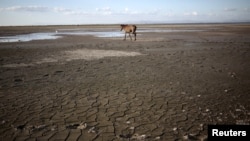A new weather monitoring system to better forecast drought in Central America could help the region's governments and farmers avoid major crop losses and boost resilience to recurring water shortages, the United Nations says.
The tool is based on existing warning systems, and uses satellite and geospatial data to map areas where crops could be affected by drought, according to the U.N. Food and Agriculture Organization (FAO).
Central America is one of the regions most vulnerable to extreme weather exacerbated by climate change, and farmers are already struggling, the FAO says.
The tool will target mainly subsistence and small-scale maize and bean farmers in Central America's "Dry Corridor" running through Guatemala, El Salvador, Honduras and Nicaragua where about 10.5 million people live.
"The aim of the system is to monitor the situation of crops in the field every ten days," said Oscar Rojas, a natural resources officer with the FAO.
"For governments, this is important in order to activate their national drought mitigation plans and to foresee districts that may present food insecurity problems," he told the Thomson Reuters Foundation.
Two consecutive years of drought from 2015 to mid-2016, linked to a powerful El Nino weather phenomenon, decimated crop harvests in parts of Central America and left 3.5 million people in need of food aid.
Experts say more accurate, timely and high-quality data on climate and weather patterns are needed to help government authorities forecast drought more effectively, and activate an early response to prevent crop losses and hunger.
The new tool includes land-use maps, crop-sowing dates and cycles, among other information, to more accurately pinpoint periods and agricultural areas of low rainfall, the FAO said.
Weather monitoring systems can help farmers decide when to plant crops and guide government funding for water harvesting and irrigation projects, the FAO said.
Climate change is expected to bring more frequent and severe droughts and floods around the world, making a deeper understanding of the way global warming affects local weather patterns crucial, experts say.
The FAO said the Central America tool could also be used by insurance companies to devise index-based policies for weather-related crop losses.





